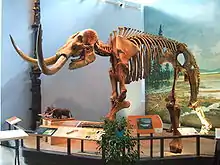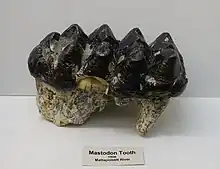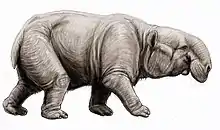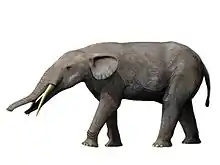Mammutidae
Mammutidae is an extinct family of proboscideans that appeared during the Oligocene epoch and survived until the start of the Holocene. Mammutids ranged very widely, with fossils found in North America, Africa, and throughout Eurasia. The family was first described in 1922, classifying fossil specimens of the type genus Mammut (mastodons), and has since been placed in various arrangements of the order. The name "mastodon" derives from Greek, μαστός "nipple" and ὀδούς "tooth", as with the genus, referring to their characteristic teeth that distinguishes them from other proboscideans.
| Mammutidae | |
|---|---|
 | |
| Mounted Mammut skeleton, Museum of the Earth | |
| Scientific classification | |
| Domain: | Eukaryota |
| Kingdom: | Animalia |
| Phylum: | Chordata |
| Class: | Mammalia |
| Order: | Proboscidea |
| Clade: | Elephantimorpha |
| Clade: | †Mammutida |
| Superfamily: | †Mammutoidea Hay, 1922[2] |
| Family: | †Mammutidae Hay, 1922 |
| Genera[3] | |
|
†Eozygodon Tassy and Pickford, 1983 | |
| Synonyms | |
| |
Description

Mammutids are characterised by their zygodont (having the opposite cusps merged into ridges) molars which are morphologically conservative (showing little variation) amongst all members of the family.[6] Like other members of Elephantimorpha, mammutids exhibited horizontal tooth replacement like modern elephants.[7] Early members of the group like Eozygodon and Zygolophodon had elongate lower jaws with lower incisors/tusks, while in later representatives like Sinomammut and Mammut, the lower incisors/tusks were either lost or only vestigially present, and the lower jaws shortened (brevirostrine). This process happened convergently amongst other elephantimorph proboscideans, including gomphotheres, stegodontids, and elephantids.[8][9] The mammutid "Mammut" borsoni is one of the largest of all proboscideans, with one specimen having an estimated mass of 16 tonnes, making it one of the largest land mammals of all time.[10]
Evolution
Mammutids are the most basal group within Elephantimorpha, with gomphotheres being more closely related to elephants,[11][12] Mammutids originated in Africa during the Late Oligocene, and entered Eurasia across the "Gomphotherium land bridge" during the early Miocene, around 18 million years ago. Mammutid remains are generally rare in Eurasia in comparison to contemporary gomphotheres and deinotheres.[6] During the late early Miocene, around 16.5 million years ago,[13] a population of Zygolophodon entered North America, giving rise to Mammut.[6] The youngest records of mammutids in Africa date to around 13 million years ago.[14] At the beginning of the Pleistocene, around 2 to 2.5 million years ago, the last of the Eurasian mammutids, "Mammut" borsoni became extinct, with members of Mammut persisting in North America until the end of the Pleistocene, approximately 11,000 years ago.[6]
References
- "Mammutidae in the Paleobiology Database". Fossilworks. Retrieved 17 December 2021.
- Hay, Oliver Perry (1922). "Further observations on some extinct elephants" (PDF). Proceedings of the Biological Society of Washington. 35: 97–101. Retrieved 2019-10-07.
- Shoshani, Jeheskel; Pascal Tassy (2005). "Advances in proboscidean taxonomy & classification, anatomy & physiology, and ecology & behavior". Quaternary International. 126–128: 5–20. Bibcode:2005QuInt.126....5S. doi:10.1016/j.quaint.2004.04.011.
- Wang, S.-Q.; Zhang, X.-X.; Li, C.-X. (2020). "Reappraisal of Serridentinus gobiensis Osborn & Granger and Miomastodon tongxinensis Chen: the validity of Miomastodon" (PDF). Vertebrata PalAsiatica. doi:10.19615/j.cnki.1000-3118.200310. Retrieved 2020-03-15.
- Dimila Mothé; Leonardo S. Avilla; Desi Zhao; Guangpu Xie; Boyang Sun (2016). "A new Mammutidae (Proboscidea, Mammalia) from the Late Miocene of Gansu Province, China". Anais da Academia Brasileira de Ciências. 88 (1): 65–74. doi:10.1590/0001-3765201520150261. PMID 26839998.
- Koenigswald, Wighart; Březina, Jakub; Werneburg, Ralf; Göhlich, Ursula (2022). "A partial skeleton of "Mammut" borsoni (Proboscidea, Mammalia) from the Pliocene of Kaltensundheim (Germany)". Palaeontologia Electronica. doi:10.26879/1188.
- Sanders, William J. (2018-02-17). "Horizontal tooth displacement and premolar occurrence in elephants and other elephantiform proboscideans". Historical Biology. 30 (1–2): 137–156. doi:10.1080/08912963.2017.1297436. ISSN 0891-2963.
- Mothé, Dimila; Avilla, Leonardo S.; Zhao, Desi; Xie, Guangpu; Sun, Boyang; Mothé, Dimila; Avilla, Leonardo S.; Zhao, Desi; Xie, Guangpu (2016). "A new Mammutidae (Proboscidea, Mammalia) from the Late Miocene of Gansu Province, China". Anais da Academia Brasileira de Ciências. 88 (1): 65–74. doi:10.1590/0001-3765201520150261. ISSN 0001-3765. PMID 26839998.
- Mothé, Dimila; Ferretti, Marco P.; Avilla, Leonardo S. (2016-01-12). Beatty, Brian Lee (ed.). "The Dance of Tusks: Rediscovery of Lower Incisors in the Pan-American Proboscidean Cuvieronius hyodon Revises Incisor Evolution in Elephantimorpha". PLOS ONE. 11 (1): e0147009. doi:10.1371/journal.pone.0147009. ISSN 1932-6203. PMC 4710528. PMID 26756209.
- Larramendi, A. (2016). "Shoulder height, body mass and shape of proboscideans" (PDF). Acta Palaeontologica Polonica. 61. doi:10.4202/app.00136.2014.
- Shoshani, J.; Ferretti, M.P.; Lister, A.M.; Agenbroad, L.D.; Saegusa, H.; Mol, D.; Takahashi, K. (July 2007). "Relationships within the Elephantinae using hyoid characters". Quaternary International. 169–170: 174–185. Bibcode:2007QuInt.169..174S. doi:10.1016/j.quaint.2007.02.003. ISSN 1040-6182.
- Baleka, Sina; Varela, Luciano; Tambusso, P. Sebastián; Paijmans, Johanna L.A.; Mothé, Dimila; Stafford, Thomas W.; Fariña, Richard A.; Hofreiter, Michael (December 2021). "Revisiting proboscidean phylogeny and evolution through total evidence and palaeogenetic analyses including Notiomastodon ancient DNA". iScience. 25 (1): 103559. doi:10.1016/j.isci.2021.103559. PMC 8693454. PMID 34988402.
- Koenigswald, Widga & Göhlich (2021): New mammutids (Proboscidea) from the Clarendonian and Hemphillian of Oregon – a survey of Mio-Pliocene mammutids from North America
- Pickford, M. 2007. New mammutid proboscidean teeth from the middle Miocene of tropical and southern Africa. Palaeontologia Africana 42: 29–35.


